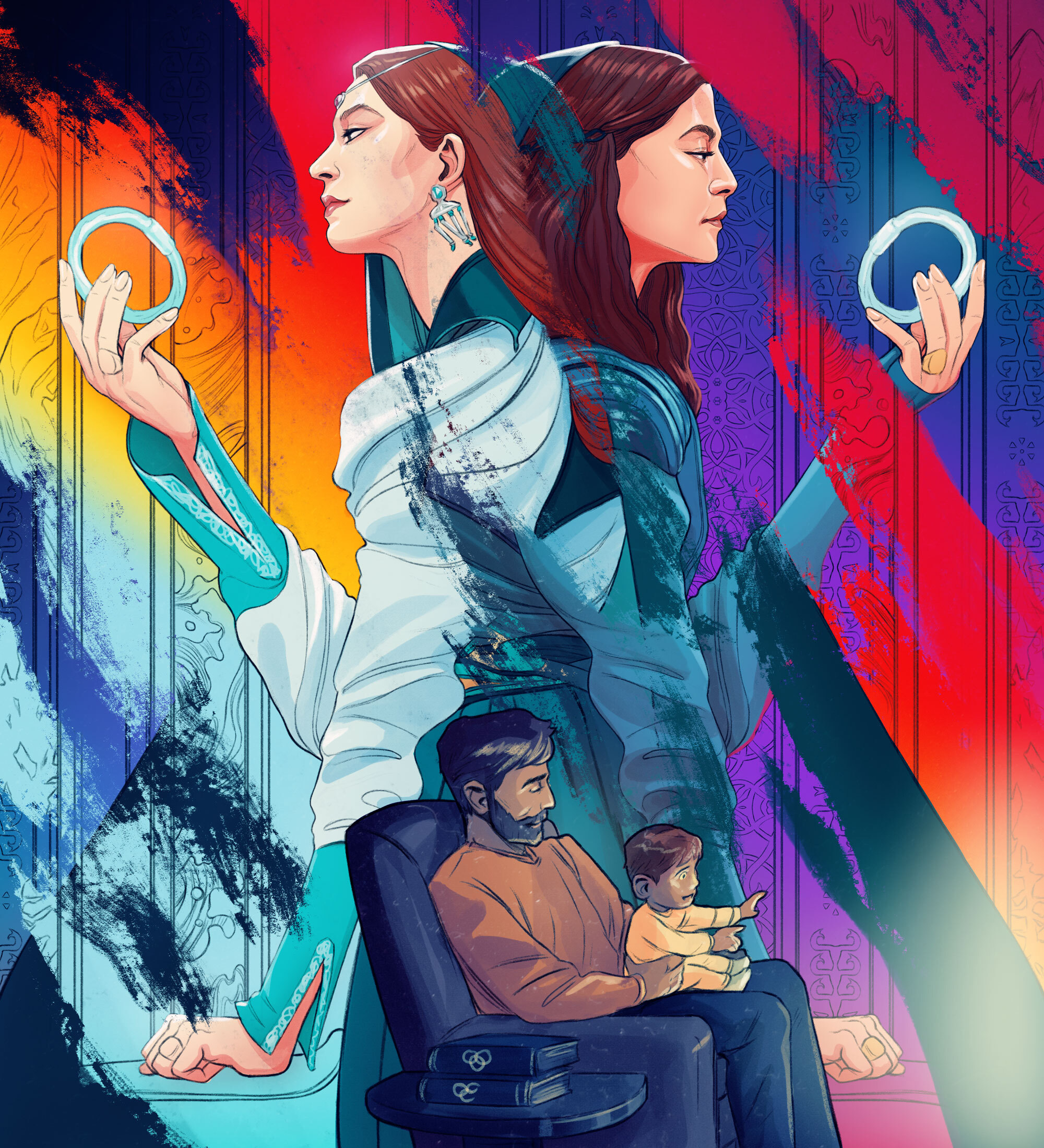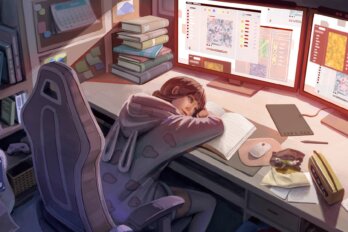In the summer of 1997, when I was twelve, I randomly picked up a book in a bookstore. It was the cover art that caught my eye. Some kind of knight? Some kind of sorceress? People riding horses? That was enough for me. The book was called The Eye of the World, and I tore through its some 750 pages, thrilled that author Robert Jordan, the pen name of James Oliver Rigney Jr., had already written six other tomes in the series.
The Wheel of Time series is a classic hero’s journey: a farm boy with uncertain parentage leaves his small village and goes on a quest to help save the world from evil. Simplifying the narrative in this way is unfair, though, given how complex the story quickly becomes. As straightforward as the overarching premise that sets the stage may be, nobody would call the end product anything other than epic. Jordan created dozens of distinct cultures and deeply realized cities and lands, developed a brilliant and complex magic system, and crafted histories that date back centuries.
At a time when fantasy writers were still hewing close to the high-fantasy legacy of J. R. R. Tolkien—elves, dwarves, wizards, orcs, and the like, all for the most part male—Jordan offered a flipped script: men who had unworldly abilities (in the books, the ability to “channel” the “One Power”) were destined to go mad; women, however, largely part of an order called Aes Sedai, controlled their abilities gracefully, powerfully, elegantly. Despite the series largely revolving around three male protagonists, the female characters were the true anchors of the story and, after the first book, held roughly an equal number of viewpoints and words as their male counterparts.
After the first book was published, in 1990, The Wheel of Time became beloved—90 million books sold and counting. It’s now being adapted into a TV series by Amazon, to premiere November 19. But the books have drawn fair criticism over the years. Scenes are overly described. Plots are drawn out. Major events are exasperatingly re-presented through various perspectives. There are so many secondary and tertiary characters that a glossary is necessary. And basically every beloved character sports thick plot armour: there is no Red Wedding in The Wheel of Time. Still, the richly developed world made readers like me want to know more, to be further immersed in these invented lands. So we went online.
When I was around fourteen, I remember my mum asking me what I was doing on the family computer, clearly full of late-1990s parental concern that I was up to no good or messaging with identity thieves or predators. She laughed and let me be when I said I was messaging with other fans of The Wheel of Time. I had signed up on wotmania.com by creating a username and password, undoubtedly the first I ever made on the internet and both long forgotten. (They were likely deeply nerdy and profoundly embarrassing to nonfans.) At one point, I answered a forty-question personality test and was assigned a character from the book; I remember feeling disappointed by the result and thinking I had made a grave error that would be imprinted onto the internet forever. There were also polls, quizzes, and news releases. But the fan art that people uploaded, which took ages to download on dial-up internet, never connected with me: the rendered characters, creatures, cities, or lands were never how I had imagined them.
I passed most of my time on the site scrolling through the forums, reading fans dissecting the books or posing theories—extending this universe as far as we could take it. It’s where I made my first internet friends (basically usernames I recognized and followed), a notion—friendship through social media—now so commonplace that it’s often ridiculed as less-than, like feeling a strong connection to a character in a fantasy book. The site took a kid from a small town and threw him into two much wider worlds, one imaginary and one largely intangible, and gave validation that I wasn’t the only one who cared about these make-believe fates.
You never really outgrow a series that you adored when you were young. My fandom has been quiet but runs deep. Allow me to share a few personal examples. Christmas, 1999: my parents gift me the Wheel of Time video game, which I’m excited to try until I realize that our computer is only fast enough to run Minesweeper. The game’s CD-ROM sits in a drawer for years, until we upgrade to a better PC, after which my two sisters cackle behind my back while I duck and bob, flinch and twist in my chair, as if I really am being chased by beastly Trollocs and eyeless Myrddraal. Summer, 2013: after a year working abroad, I return home to a copy of A Memory of Light, the fourteenth and final book of the series. When I finish it, I take it to my childhood bedroom and place it on a wooden shelf—one that I had custom built by a local woodworker to perfectly fit the books—alongside thirteen other first-edition hardbacks that I’d collected, hunting down the early ones in dusty used bookstores. Spring, 2019: my wedding ceremony. My mum rises to speak. She quotes some of my favourite authors on friendship and love, and then she quotes Robert Jordan. I’d like to think that it was my mum, standing there speaking at my wedding, that made tears pour down my cheeks, but I won’t deny that hearing Jordan’s words played a tiny role.
On November 19, another day will be marked in my Wheel of Time journey. I will sit down with my wife (who recently read the first book), our nearly-one-year-old boy dreaming in his crib, and watch a story so ingrained in the imagination of my teenagehood be realized on TV. Most fans of the book series, at one point or another, thought it would make a great TV show; there was chatter on wotmania.com even back in the ’90s. After the success of the Lord of the Rings films and, later, the Game of Thrones HBO series, the passing thought became an inevitability. And Amazon has placed no small bet on the Wheel of Time show’s success, reportedly spending $10 million (US) per episode. (Game of Thrones, by contrast, started out with a $6 million per episode budget.) The announcement thrilled fans.
When details of the show began to filter out, however, a certain subset of fans was quick to hurl complaints about everything from a particularly important sword looking wrong to casting selections that were more diverse than what likely had appeared in most white readers’ minds. Change is expected in any book-to-screen adaptation. It’s occasionally welcomed. The Lord of the Rings film trilogy made one of its female characters more prominent, an adaptation from a book series—the first volume of which was published in 1954—that was entirely dominated by male characters. Amazon’s marketing copy for The Wheel of Time names and spotlights a female character over Jordan’s male protagonist—perhaps because the actor, Rosamund Pike, has the biggest profile of the cast, or because, since 1990, the industry has recognized that audiences want more than male-led stories. But even positive changes are often met with responses ranging from dismissal to fury and vitriol. It may not be what was changed but that something was changed at all. After all, adapting any beloved book to screen will always threaten a young mind’s most sacred faculty: imagination.
The real world grows up around us, but the make-believe worlds that exist in black ink on white pages are ours, and ours alone, to colour in. What readers imagine is unique, fiercely held, and impossible to replicate. Adaptations destroy these individually created pictures by forcing new images on us—ones that become virtually impossible to unsee. Can you picture how you imagined Aragorn when you first read The Fellowship of the Ring or do you now see only Viggo Mortensen? How fast did your image of Arya Stark or Hermione Granger vanish when you watched Game of Thrones on TV or the Harry Potter movies? My son, when he grows up, will experience the Wheel of Time books differently than I, and other early fans, did: he will read them in a world where the characters are the actors and the lands are filmed locations and built sets.
In 2007, Robert Jordan died, at fifty-eight, from a rare blood disease, before he could finish The Wheel of Time. Heartache was quickly followed by uncertainty. The final three books were completed by another established fantasy writer, Brandon Sanderson, who was selected to take some already written chapters and scenes, write new ones based on extensive notes and dictations left by Jordan, and weave the whole thing together. Sanderson did an admirable job, but in the end, even the conclusion of Jordan’s great series must have differed from how he had imagined it.
Two years after Jordan’s death, wotmania.com folded, its members fading away or migrating to other fan sites. I was sad to hear the news even though it had been years since I had last logged in—the book series no longer occupied a prominent space in my life. It may have been called “WoTmania,” but there was nothing manic about the site at all: it was fandom, pure and simple, expressions of imagination and community and enthusiasm wrapped up in late ’90s and early 2000s internet innocence. Many similar online spaces today are full of people quick to judge and dismiss the turns of someone else’s imagination, but logging in to wotmania.com was as welcoming as picking a book off a shelf.
It was the same feeling I had when I read The Wheel of Time’s final book, in 2013. Ten pages in, I had stepped back into my early teenage mindset, back into that world I had so vividly pictured and had held so dear. I had just turned twenty-seven, with fantasy not really appearing on my reading list anymore, but I dove into the last instalment to complete an adventure begun by a twelve-year-old boy. I had read the series for no other reason than delight, and that delight was surprisingly easy to embrace once again.
Jordan had a medium through which to tell his story: millions of words on more than 10,000 pages. We, as early fans, had online forums like wotmania.com through which to theorize, speculate, and let our imaginations grow beyond the covers. And so it is with directors, screenwriters, cinematographers, costume designers, and prop creators: they have a new medium on which to project a story, but how their vision is realized will inevitably run contrary to our own. On the eve of the TV series’ release, the challenge for every fan of The Wheel of Time will be to watch Amazon’s adaptation with the same kind of reader’s delight and to try not to pick apart scenes for accuracy or scrutinize for details misrepresented or invented. The challenge will be to enjoy, as we did with the final three books written by someone else, seeing a world we love through new eyes.





